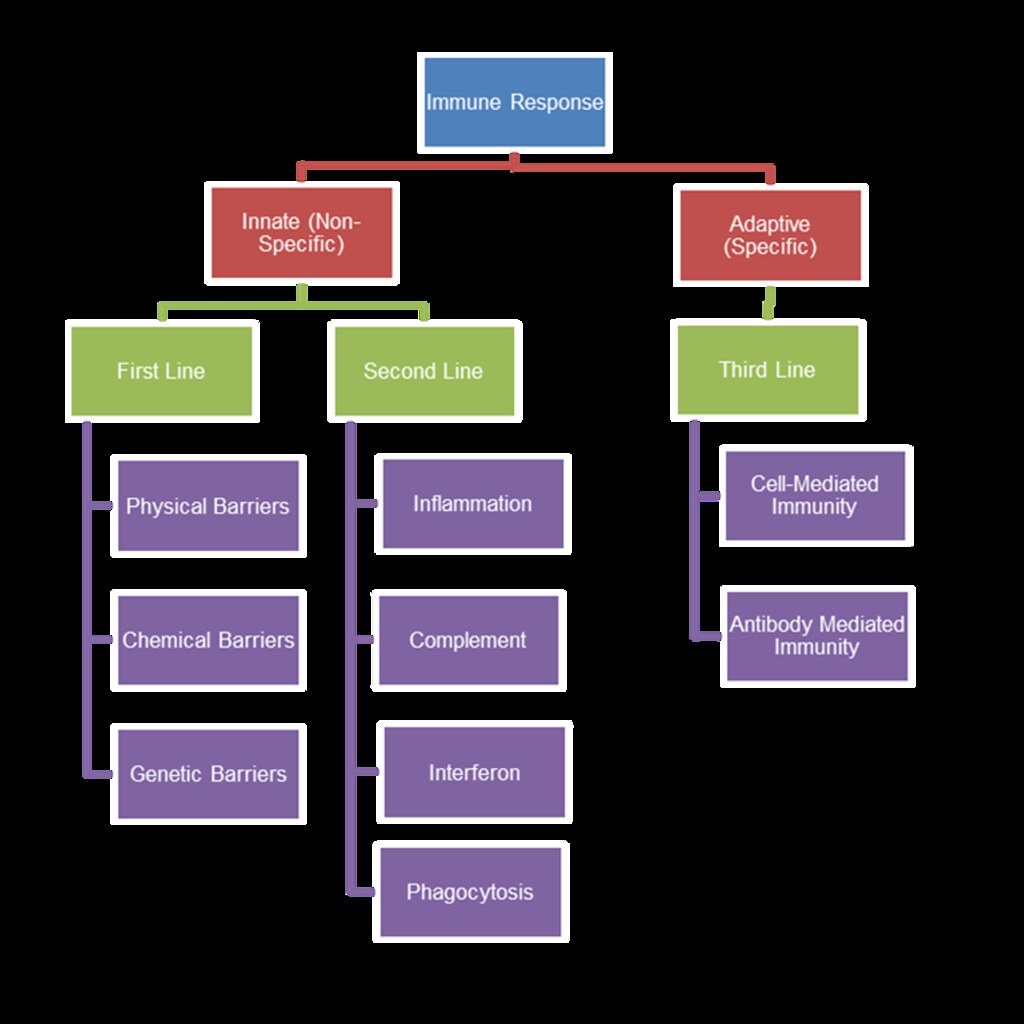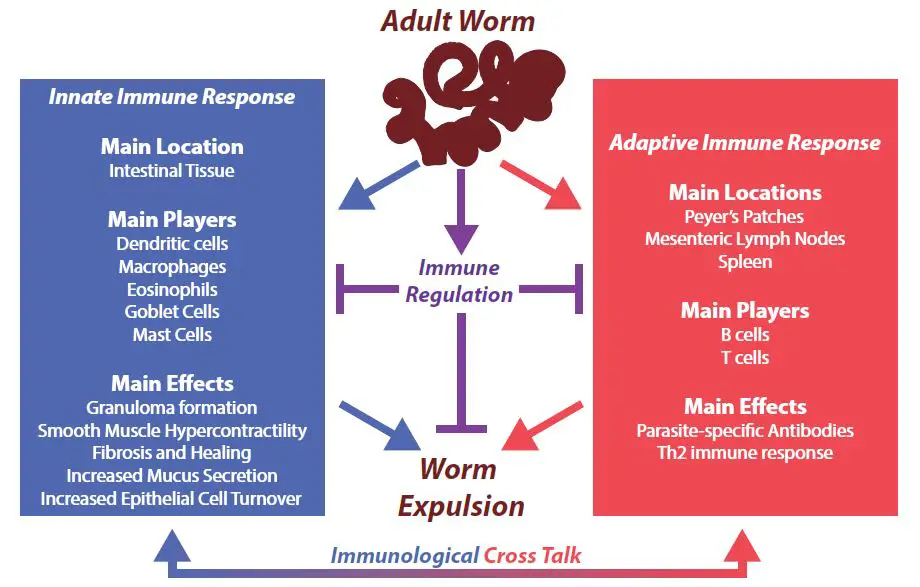Innate vs Adaptive Immunity: What are the differences between innate and adaptive immunity?
The human body has two protective immunological systems against pathogens: the innate immunity and the adaptive immunity. In this quick and easy lesson, we will explain the differences between the innate and adaptive immunity.

1. Components: Innate vs Adaptive Immunity
The innate immunity and adaptive immunity differ based on the type of components that are used to protect the human body. For example, the innate immunity consists of neutrophils, dendritic cells, natural killer cells, macrophages, complements, physical barriers. On the other hand, the adaptive immunity contains components such as T cells, B cells, and antibodies to protect us from viruses, bacteria, and other pathogens.
2. Speed of Response: Innate vs Adaptive Immunity
The speed of response to pathogens differs between the innate immunity and adaptive immunity. Innate is fast, with a response to pathogens that occurs rapidly within minutes to hours. On the other hand, the adaptive immunity is slower and develops over long periods.
3. Specificity: Innate vs Adaptive Immunity
Innate immunity is non-specific, meaning the components of this system will attack any invading pathogen, regardless of the identity of the pathogen. Adaptive immunity is highly specific, meaning that fighters of this system have specific roles and specific pathogens they target and attack.
4. Memory: Innate vs Adaptive Immunity
The innate immunity does not have any memory. Adaptive immunity has memory, so when we have a second infection of the same pathogen from before, the adaptive response knows exactly how to get rid of the pathogen, more quickly and effectively.
5. Activation: Innate vs Adaptive Immunity
Innate immunity is activated by free antigen, while adaptive immunity requires antigen presentation for T cell activation.

<Scroll all the way down to test your knowledge! Practice Test and Questions on Immunology: Innate vs Adaptive Immunity :D>
What is the immune system?
The immune system is our human body’s defense system and mechanisms that protect us from pathogens and infectious diseases. There are four main types of foreign agents (pathogens) that the immune system defends against: Bacteria, Viruses, Fungi, and Parasites.
Does that mean that all bacteria, viruses, fungi, and parasites are bad guys? The short answer is no. All over our body are microbiota. Microbiota are microorganisms that live within our human body, perhaps on our skin, within our small intestines, you name it. In fact, the human body is made up of 100 trillion microbial cells, including bacterial and fungal, compared to 30 trillion human cells. That’s about 70-90% of all cells on your body! (American Museum of Natural History)
Many microbial cells are harmless and are essential to the health of our bodies. We call them commensal microbiota because they have a commensal symbiotic relationship with our human cells. This means that microbiota provide benefits to our human cells, just as our human cells provide benefits to the microbiota. For example, microbes in the large intestine enjoy residing in the comfy long tube pockets because they derive nutrients and sustenance from the ball of feces rolling slowly down. At the same time, they produce essential vitamins, such as Vitamin K, in the large intestines, allowing us to maintain a healthy body. Vitamin K specifically is important for blood clotting!
Can microbiota have the potential to harm the human body? Yes, only if they are on the “wrong side” of the barrier. For example, there are many bacteria like Streptococcus that live on top of your skin. It’s not every day that you get sick from Streptococcus, but only when the barrier of your skin breaches, like from a paper cut, then bacteria like Streptococcus enter into your skin and can threaten your health. That’s what it means to be physically on the wrong side, resulting in a possible infection, fever, inflammation, and the call for our immune systems to rescue us and defeat the pathogen.
What are Opportunistic Pathogens?
Another example of “wrong side” goes back to our large intestine example. The microbiota that live in our large intestine and help create Vitamin K and other essential vitamins include Lactobacillus, Bifidobacterium, Methanogens, Sulfate reducing bacteria, Bacteroides, Enterococcus, Escherichia coli, and Clostridium, to name a few (Kenyon University). Usually, our large intestines function normally, assisting in digestive processes with the help of our healthy microbiota. However, when the microbiome is disturbed and sometimes, bacteria normally not present in the colon’s appendix end up clustering in the appendix, this leads to appendicitis, or an inflamed appendix. The bacteria entered the wrong side. What were previously harmless and beneficial bacteria to our bodies have now become a threat.
Both of these examples illustrate the transition of microbiota into opportunistic pathogens. Opportunistic pathogens were previous commensal microorganisms but by entering the “wrong side,” they become pathogenic and a threat to our immune systems.

Practice Test and Answers: Immunology 101 – Innate vs Adaptive Immunity
Answers to Practice Test Questions: Immunology 101 – Innate vs Adaptive Immunity
- Macrophages are a part of which immune response? Innate immunity! Macrophages are one of the first non-specific responders in our immune system, and gobble up the bad guys (invading pathogens!)
- T cells are a part of which type of immunity? Adaptive immunity. T cells and B cells are our immune system’s adaptive responders. They target very specific antigens, viruses, bacteria, and other foreign pathogens.
- Which type of immunity responds quicker to a non-specific invading pathogen? Innate immunity has faster speed than adaptive immunity in general. Remember, innate immunity are one of the first responders of our immune system. They are like first-aid responders (macrophages, neutrophils) who give general treatment to our body.
- Billy got sick with the same virus again. Which type of immunity is now in action again? It is adaptive immunity! The body’s immune system remembers the virus because the virus has the same outer coat pattern that our adaptive immunity specifically remembers and targets. That virus’s pattern is like on our immune system’s CIA Most Wanted list; our adaptive immunity recognizes that pattern and now goes target it.
- Which is not a difference between adaptive immunity and innate immunity? Answer: Sensitivity! Sensitivity =/ (is not) specificity. Tricky, tricky. 😉
How did you do on our <Immunology 101: Innate vs Adaptive Immunity> Test? Keep practicing and happy learning! 😀 Hope it helped!
Click and check out these popular articles for more information: 🙂
Circulatory System: Blood Flow Pathway Through the Heart
Circulatory System: Heart Structures and Functions
Ductus Arteriosus Vs Ductus Venosus Vs Foramen Ovale: Fetal Heart Circulation
Cardiac Arrhythmias: Definition, Types, Symptoms, and Prevention
Upper Vs Lower Respiratory System: Upper vs Lower Respiratory Tract Infections
Seven General Functions of the Respiratory System
Digestive System Anatomy: Diagram, Organs, Structures, and Functions
Kidney Embryology & Development: Easy Lesson
Psychology 101: Crowd Psychology and The Theory of Gustave Le Bon
Copyright © 2022 Moosmosis Organization: All Rights Reserved
All rights reserved. This essay first published on moosmosis.org or any portion thereof may not be reproduced or used in any manner whatsoever
without the express written permission of the publisher at moosmosis.org.

Please Like and Subscribe to our Email List at moosmosis.org, Facebook, Twitter, Youtube to support our open-access youth education initiatives! 🙂














Excellent article on immunology! I learned something new today 😄
LikeLiked by 2 people
Very helpful and informative!
LikeLiked by 2 people
Thx for the info 👍🏼very informative
LikeLiked by 2 people
Thanks Peach! You’re very kind! Glad you enjoyed it 🙂
LikeLiked by 1 person
Great info on immunity! Definitely important in these COVID19 times
LikeLiked by 1 person
Excellently written! I love the practice questions and your awesome article on immunity!
LikeLiked by 1 person
Awesome article! Excellent points on immunity
LikeLiked by 1 person
This is really helpful! My exam on the adaptive versus innate immunity types is tomorrow — perfect article!!
LikeLiked by 2 people
Good luck on your exam tomorrow, Goodie!! 😀 So glad this was helpful
LikeLiked by 1 person
Excellent points about innate versus adaptive immunity! Donated cup of coffee ☕️ cheers!
LikeLiked by 2 people
Wonderful article on immunity — very important for times like these!
LikeLiked by 2 people
Awesome essay on adaptive vs innate immunity!! 🙂
LikeLiked by 2 people
Immunity for the win!
LikeLiked by 1 person
Brilliant article! Immunity is so important these days especially with COVID19.
LikeLiked by 1 person
Outstanding article on the difference between innate immunity and adaptive immunity!
LikeLiked by 1 person
Love it! Great article on innate vs adaptive immunity
LikeLiked by 1 person